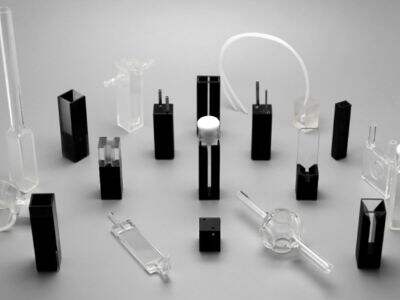Hva er spektroskopi?
Jinke Optical visste at spektroskopi har en betydelig rolle i metoden for å studere ulike stoffer av vitenskapsfolk. Det lærer dem hva slike legemer består av. Vitenskapsfolk kan se hvor mye lys et prøveabsorberer ved å bruke spesielle verktøy som de kaller spektrometer. Det vil si at de kan lære hva kjemiske komponenter i et stoff er ved å analysere hvordan det interagerer med lys. Spektroskopi finner flere anvendelser - fra å analysere helsen på vår miljø, gjennom å utvikle legemidler i apoteket, til å undersøke kriminalsaker og samle bevis.
Denne prøven er vanligvis i en spesial celle, kalt en cuvette. Den er en liten, tydelig beholder og er av stor betydning for å gjennomføre nøyaktige resultater. (som betyr at hvis cuvetten ikke er passende, vil det påvirke målingene og gi feil data). Selv om det finnes flere typer cuvetter tilgjengelig på markedet i dag, er kvarts-cuvetten den mest nøyaktige og derfor den beste valget hvis resultater fra eksperimentet skal være pålitelige.
Hvordan Hjelper Kvarts Cuvetter?
Disse cuvetter er laget av et spesialglass kjent som fuset kvarts. Den spesielle aspekten ved dette glasset er dets høye grad av gjenstandlighet, som henviser til dets evne til å la lys gå ganske lett gjennom det. Lys som går gjennom kvarts-cuvetten lar forskere oppnå skarpe og nøyaktige resultater.
Å erstatte andre materialer kan absorber eller speile en del av lyset, noe som gir mindre nøyaktige resultater. Men dette kan være et stort problem når vitenskapsmenn måler noe som teller. I tillegg kan formen på kvarts-kuvetter ikke endres, og de smelter heller ikke selv ved høye temperaturer. Resultatene kan variere siden andre materialer kanskje ikke kan tåle varmen. Disse egenskapene gjør at kvarts-kuvetter er de viktigste verktøyene i spektroskopiske studier, og lar forskerne få nøyaktige resultater hver gang.
Hvorfor bruker man kvarts-kuvetter?
Spektroskopi er en viktig teknikk som brukes i nesten alle vitenskapelige felter, og Jinke Optical har forstått at høykvalitets kuvetter er viktige for å oppnå nøyaktige resultater. Likevel har kvarts kuvetter flere fordeler som plasserer dem som den absolutte første valget blant forskere. Disse har ikke bare høy gjennomsiktighet, men de er også ekstremt robuste og tøffe. De kan tåle varme, noe som lar dem fungere utmerket i ekstreme miljøer hvor mange andre materialer feiler.
Kvarts kuvetters motstandsdyktighet mot skraper tillater at de beholder høy gjennomsiktighet etter lengre bruk. Dette er virkelig viktig fordi skrappede kuvetter kan spre lys som passerer gjennom og føre til mindre nøyaktige målinger. Kvarts kuvetter gir langt bedre resultater enn plast- eller vanlig glasskuvetter. Dette er grunnen til at forskere typisk bruker kvarts som prøveholder i spektroskopi eksperimenter.
Forbedrer Målingene Med Kvarts Kuvetter
Spektroskopiske teknikker bruker mye kvarts-kuvetter, som er avgjørende for å forbedre kvaliteten på målingene. Den veldig høy gjennomsiktigheten og varmebestandigheten til dem sørger for at forskere får pålitelige og detaljerte målinger. Kvarts-kuvetter endrer ikke seg når de interagerer med solventene og kjemikalier som brukes ved utarbeiding av prøver – i motsetning til noen andre typer materialer, noe som gjør dem til en ideell løsning for bruk i strenge laboratoriemiljøer.
En ytterligere fordel med kvarts-kuvetter er at den kvalitetsfusjonerte kvarts glass de er laget av reduserer streiflys. Ekstra lys – streiflys – vil ikke ha verdi for målingene. Kvarts-kuvetter minimerer dette uønskede lyset slik at data som samles inn er nøyaktig og pålitelig. Dette er hva som gjør dem til så verdifulle verktøy for en rekke vitenskapelige anvendelser, fra medisinsk testing til overvåking av miljøfare.
 EN
EN
 AR
AR
 BG
BG
 HR
HR
 CS
CS
 DA
DA
 NL
NL
 FI
FI
 FR
FR
 DE
DE
 EL
EL
 HI
HI
 IT
IT
 JA
JA
 KO
KO
 NO
NO
 PL
PL
 PT
PT
 RO
RO
 RU
RU
 ES
ES
 SV
SV
 TL
TL
 ID
ID
 LV
LV
 SR
SR
 SK
SK
 UK
UK
 VI
VI
 HU
HU
 MT
MT
 TH
TH
 TR
TR
 FA
FA
 AF
AF
 MS
MS
 GA
GA
 IS
IS
 LA
LA
 KK
KK







